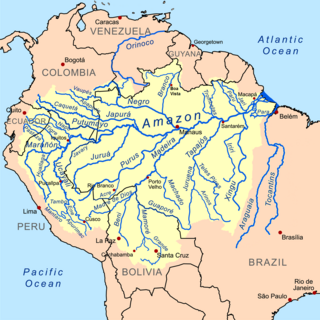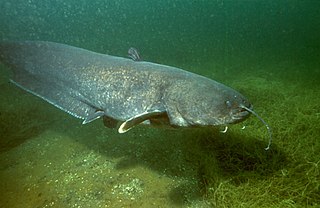
Catfish are a diverse group of ray-finned fish. Named for their prominent barbels, which resemble a cat's whiskers, catfish range in size and behavior from the three largest species alive, the Mekong giant catfish from Southeast Asia, the wels catfish of Eurasia, and the piraíba of South America, to detritivores, and even to a tiny parasitic species commonly called the candiru, Vandellia cirrhosa. Neither the armour-plated types nor the naked types have scales. Despite their name, not all catfish have prominent barbels or "whiskers". Members of the Siluriformes order are defined by features of the skull and swimbladder. Catfish are of considerable commercial importance; many of the larger species are farmed or fished for food. Many of the smaller species, particularly the genus Corydoras, are important in the aquarium hobby. Many catfish are nocturnal, but others are crepuscular or diurnal.

Callichthyidae is a family of catfishes, called armored catfishes due to the two rows of bony plates along the lengths of their bodies. It contains some of the most popular freshwater aquarium fish, such as many species in the genus Corydoras.

The flathead catfish, also called by several common names including mudcat or shovelhead cat, is a large species of North American freshwater catfish in the family Ictaluridae. It is the only species of the genus Pylodictis. Ranging from the lower Great Lakes region to northern Mexico, it has been widely introduced and is an invasive species in some areas. The closest living relative of the flathead catfish is the much smaller widemouth blindcat, Satan eurystomus.

The Amazon basin is the part of South America drained by the Amazon River and its tributaries. The Amazon drainage basin covers an area of about 7,000,000 km2 (2,700,000 sq mi), or about 35.5 percent of the South American continent. It is located in the countries of Bolivia, Brazil, Colombia, Ecuador, Guyana, Peru, Suriname, and Venezuela, as well as the territory of French Guiana.

The Verde River is a major tributary of the Salt River in the U.S. state of Arizona. It is about 170 miles (270 km) long and carries a mean flow of 602 cubic feet per second (17.0 m3/s) at its mouth. It is one of the largest perennial streams in Arizona.

The iridescent shark,iridescent shark catfish is a species of shark catfish native to the rivers of Southeast Asia. Despite its name, it is not a shark. It is found in the Mekong basin as well as the Chao Phraya River, and is heavily cultivated for food there.

The walking catfish is a species of freshwater airbreathing catfish native to Southeast Asia. It is named for its ability to "walk" and wiggle across dry land, to find food or suitable environments. While it does not truly walk as most bipeds or quadrupeds do, it can use its pectoral fins to keep it upright as it makes a wiggling motion with snakelike movements to traverse land. This fish normally lives in slow-moving and often stagnant waters in ponds, swamps, streams, and rivers, as well as in flooded rice paddies, or temporary pools that may dry up. When this happens, its "walking" skill allows the fish to move to other aquatic environments. Considerable taxonomic confusion surrounds this species and it has frequently been confused with other close relatives. One main distinction between the walking catfish and the native North American ictalurid catfish with which it sometimes is confused, is that the walking catfish lacks an adipose fin. It can survive 18 hours out of water.

The blue catfish is a large species of North American catfish, reaching a length of 65 in (170 cm) and a weight of 165 lb (75 kg). The continent’s largest, it can live to 20 years, with a typical fish being between 25–46 in (64–117 cm) and 30–70 lb (14–32 kg). Native distribution is primarily in the Mississippi River and Louisiana drainage systems, including the Missouri, Ohio, Tennessee, and Arkansas Rivers, the Des Moines River in south-central Iowa, the Rio Grande, and south along the Gulf Coast to Belize and Guatemala.

The Mekong giant catfish, is a large, threatened species of catfish in the shark catfish family (Pangasiidae), native to the Mekong basin in Southeast Asia and adjacent China. It is considered critically endangered due to overfishing and habitat loss.

The Thamirabarani or Tamraparni or Porunai is a perennial river that originates from the Agastyarkoodam peak of Pothigai hills of the Western Ghats, above Papanasam in the Ambasamudram taluk. It flows through Tirunelveli and Thoothukudi districts of the Tamil Nadu state of southern India into the Gulf of Mannar. It was called the Tamraparni River in the pre-classical period, a name it lent to the island of Sri Lanka. The old Tamil name of the river is Porunai. From the source to sea, the river is about 128 kilometres (80 mi) long and is the only perennial river in Tamil Nadu. This river flows towards north direction initially. However, it changes to east direction later.

Basa is a species of catfish in the family Pangasiidae. Basa are native to the Mekong and Chao Phraya basins in Mainland Southeast Asia. These fish are important as a food source, and also on the international market. They are often labelled in North America and Australia as "basa fish", "swai", or "bocourti". In the UK all species of Pangasius may legally be described as "river cobbler", "cobbler", "basa", "pangasius", "panga", or any of these with the addition of "catfish". In the rest of Europe, these fish are commonly marketed as "pangasius" or "panga". In Asian markets, names for basa include "Pacific dory" and "patin". Other related shark catfish may occasionally be incorrectly labeled as basa fish, including P. hypophthalmus and P. pangasius.

The wels catfish, also called sheatfish or just wels, is a large species of catfish native to wide areas of central, southern, and eastern Europe, in the basins of the Baltic, Black and Caspian Seas. It has been introduced to Western Europe as a prized sport fish and is now found from the United Kingdom east to Kazakhstan and China and south to Greece and Turkey.

Manatee Springs State Park is a Florida State Park located six miles west of Chiefland on SR 320, off US 19. Manatee Spring is a first magnitude spring that flows directly into the Suwannee River by way of a short run. Present also are swamps and hardwood wetlands along the Suwannee, along with many sinkhole ponds, including one with a cave 90 feet below the ground that connects to a popular divers' destination known as the catfish hotel.

Callichthys callichthys, the cascarudo, armored catfish, bubblenest catfish, hassar, or mailed catfish, is a subtropical freshwater fish belonging to the subfamily Callichthyinae of the family Callichthyidae.

Ameiurus is a genus of catfishes in the family Ictaluridae. It contains the three common types of bullhead catfish found in waters of the United States, the black bullhead, the brown bullhead, and the yellow bullhead, as well as other species, such as the white catfish, which are not typically called "bullheads".

Liosomadoras is a genus of driftwood catfishes found in tropical South America.

Heteropneustes fossilis, also known as Asian stinging catfish or fossil cat, is a species of airsac catfish found in India, Bangladesh, Pakistan, Nepal, Sri Lanka, Thailand, Myanmar, and Bhutan. It has also been introduced to the Tigris River Basin in western Iran.

Neoarius berneyi, the highfin catfish, Berney's catfish, Berney's shark catfish, or the lesser salmon catfish, is a freshwater sea catfish that is commonly kept in aquariums. The origin of the name Neoarius berneyi is Greek, with the genus name Neoarius coming from the words neos meaning new and arios, meaning warlike or hostile, in reference to the well developed fin spines, and the species name, berneyi, comes from the ornithologist F. L. Berney.

Heterobranchus bidorsalis, the African catfish or eel-like fattyfin catfish, is an airbreathing catfish found in Africa. It is closely related to the vundu catfish, which is well-known among fishermen.

Neoarius is a genus of sea catfishes found on and around the island New Guinea and Australia. They are found in marine, brackish waters and fresh waters with several species restricted solely to freshwater rivers. There are currently 10 described species in this genus.




















